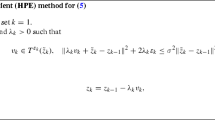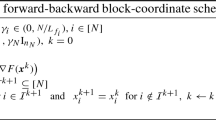Abstract
Supported by the recent contributions in multiple domains, the first-order splitting became algorithms of choice for structured nonsmooth optimization. The large-scale noisy contexts make available stochastic information on the objective function and thus, the extension of proximal gradient schemes to stochastic oracles is heavily based on the tractability of the proximal operator corresponding to nonsmooth component, which has been highly exploited in the literature. However, some questions remained about the complexity of the composite models with proximal untractable terms. In this paper we tackle composite optimization problems, assuming only the access to stochastic information on both smooth and nonsmooth components, with a stochastic proximal first-order scheme with stochastic proximal updates. We provide sublinear \(\mathcal {O}\left( \frac{1}{k} \right) \) convergence rates (in expectation of squared distance to the optimal set) under the strong convexity assumption on the objective function. Also, linear convergence is achieved for convex feasibility problems. The empirical behavior is illustrated by numerical tests on parametric sparse representation models.


Similar content being viewed by others
Notes
Data generating code available athttps://github.com/pirofti/SSPG.
References
Asi, H., Duchi, J.C.: Stochastic (approximate) proximal point methods: convergence, optimality, and adaptivity. SIAM J. Optim. 29(3), 2257–2290 (2019)
Bauschke, H., Deutsch, F., Hundal, H., Park, S.-H.: Accelerating the convergence of the method of alternating projections. Trans. Am. Math. Soc. 355(9), 3433–3461 (2003)
Bauschke, H.H., Borwein, J.M., Li, Wu: Strong conical hull intersection property, bounded linear regularity, jameson’s property (g), and error bounds in convex optimization. Math. Program. 86(1), 135–160 (1999)
Beck, A., Teboulle, M.: A fast iterative shrinkage-thresholding algorithm for linear inverse problems. SIAM J. Imaging Sci. 2(1), 183–202 (2009)
Bianchi, P.: Ergodic convergence of a stochastic proximal point algorithm. SIAM J. Optim. 26(4), 2235–2260 (2016)
Davis, D., Drusvyatskiy, D.: Stochastic model-based minimization of weakly convex functions. SIAM J. Optim. 29(1), 207–239 (2019)
Elad, M.: Sparse and redundant representations: from theory to applications in signal and image processing. Springer, New York (2010)
Hallac, D., Leskovec, J., Boyd, S.: Network lasso: clustering and optimization in large graphs. In: Proceedings of the 21th ACM SIGKDD International Conference on Knowledge Discovery and Data Mining, pp. 387–396 (2015)
Koshal, J., Nedic, A., Shanbhag, U.V.: Regularized iterative stochastic approximation methods for stochastic variational inequality problems. IEEE Trans. Autom. Control 58(3), 594–609 (2012)
Moulines, E., Bach, F.R.: Non-asymptotic analysis of stochastic approximation algorithms for machine learning. In: Advances in Neural Information Processing Systems, pp. 451–459 (2011)
Nedić, A.: Random projection algorithms for convex set intersection problems. In: 49th IEEE Conference on Decision and Control (CDC), pp. 7655–7660. IEEE (2010)
Nedić, A.: Random algorithms for convex minimization problems. Math. Program. 129(2), 225–253 (2011)
Nemirovski, A., Juditsky, A., Lan, G., Shapiro, A.: Robust stochastic approximation approach to stochastic programming. SIAM J. Optim. 19(4), 1574–1609 (2009)
Nesterov, Y.: Gradient methods for minimizing composite functions. Math. Program. 140(1), 125–161 (2013)
Nesterov, Y.: Introductory Lectures on Convex Optimization: A Basic Course, vol. 87. Springer, US (2013)
Nguyen, L.M., Nguyen, P.H., van Dijk, M., Richtárik, P., Scheinberg, K., Takáč, M.: Sgd and hogwild! convergence without the bounded gradients assumption. arXiv preprint arXiv:1802.03801 (2018)
Pătraşcu, A.: New nonasymptotic convergence rates of stochastic proximal point algorithm for stochastic convex optimization. Optimization, 1–29 (2020)
Patrascu, A., Necoara, I.: Nonasymptotic convergence of stochastic proximal point methods for constrained convex optimization. J. Mach. Learn. Res. 18(1), 7204–7245 (2017)
Rockafellar, R.T., Wets, R.J.-B.: Variational Analysis, vol. 317. Springer, Berlin (2009)
Rockafellar, R.T.: Convex Analysis. Princeton University Press, Princeton, New Jersey (1988)
Rockafellar, R.T., Wets, R.J.-B.: On the interchange of subdifferentiation and conditional expectation for convex functionals. Stochastics 7(1), 173–182 (1982)
Rosasco, L., Villa, S., Vũ, B.C.: Convergence of stochastic proximal gradient algorithm. Appl. Math. Optim. 82, 1–27 (2019)
Ryu, E.K., Boyd, S.: Stochastic proximal iteration: a non-asymptotic improvement upon stochastic gradient descent. Author website, early draft (2016)
Salim, A., Bianchi, P., Hachem, W.: Snake: a stochastic proximal gradient algorithm for regularized problems over large graphs. IEEE Trans. Autom. Control 64(5), 1832–1847 (2019)
Shalev-Shwartz, S., Singer, Y., Srebro, N., Cotter, A.: Pegasos: primal estimated sub-gradient solver for svm. Math. Program. 127(1), 3–30 (2011)
Shi, W., Ling, Q., Gang, W., Yin, W.: A proximal gradient algorithm for decentralized composite optimization. IEEE Trans. Signal Process. 63(22), 6013–6023 (2015)
Stoican, F., Irofti, P.: Aiding dictionary learning through multi-parametric sparse representation. Algorithms 12(7), 131 (2019)
Toulis, P., Tran, D., Airoldi, E.: Towards stability and optimality in stochastic gradient descent. In: Artificial Intelligence and Statistics, pp. 1290–1298 (2016)
Varma, R., Lee, H., Kovacevic, J., Chi, Y.: Vector-valued graph trend filtering with non-convex penalties. IEEE Trans. Signal Inf. Process. Over Netw. 6, 48–62 (2019)
Wang, M., Bertsekas, D.P.: Stochastic first-order methods with random constraint projection. SIAM J. Optim. 26(1), 681–717 (2016)
Wang, X., Wang, S., Zhang, H.: Inexact proximal stochastic gradient method for convex composite optimization. Comput. Optim. Appl. 68(3), 579–618 (2017)
Yankelevsky, Y., Elad, M.: Dual graph regularized dictionary learning. IEEE Trans. Signal Inf. Process. Over Netw. 2(4), 611–624 (2016)
Zhong, W., Kwok, J.: Accelerated stochastic gradient method for composite regularization. In: Artificial Intelligence and Statistics, pp. 1086–1094 (2014)
Acknowledgements
The research of A. Patrascu was supported by a grant of the Romanian Ministry of Education and Research, CNCS - UEFISCDI, project number PN-III-P1-1.1-PD-2019-1123, within PNCDI III. Also, the research work of P. Irofti was supported by a grant of the Romanian Ministry of Education and Research, CNCS - UEFISCDI, project number PN-III-P1-1.1-PD-2019-0825, within PNCDI III..
Author information
Authors and Affiliations
Corresponding author
Additional information
Publisher's Note
Springer Nature remains neutral with regard to jurisdictional claims in published maps and institutional affiliations.
Appendix
Appendix
Proof (of Corollary 3)
For simplicity denote \(\theta _k = (1 - \mu _k\sigma _{f})\) , then Theorem 2 implies that:
By using the Bernoulli inequality \( 1- tx \le \frac{1}{1 + tx} \le (1 + x)^{-t}\) for \(t \in [0,1], x \ge 0\), then we have:
On the other hand, if we use the lower bound
then we can finally derive:
By denoting the second constant \(\tilde{\theta }_0 = \frac{1}{1+\mu _0 \sigma _f}\), then the last relation implies the following bound:
Denote \(r_k^2 = \mathbb {E}[\Vert x^k-x^*\Vert ^2]\). To derive an explicit convergence rate order we analyze upper bounds on function \(\phi \).
(i) First assume that \(\gamma \in (0, \frac{1}{2})\). This implies that \(1 - 2\gamma > 0\) and that:
On the other hand, by using the inequality \(e^{-x} \le \frac{1}{1 + x}\) for all \(x \ge 0\), we obtain:
Therefore, in this case, the overall rate will be given by:
If \(\gamma = \frac{1}{2}\), then the definition of \(\varphi _{1-2\gamma }(\frac{k}{2})\) provides that:
When \(\gamma \in (\frac{1}{2}, 1)\), it is obvious that \(\varphi _{1-2\gamma }\left( \frac{k}{2}\right) \le \frac{1}{2\gamma - 1}\) and therefore the order of the convergence rate changes into:
(ii) Lastly, if \(\gamma = 1\), by using \(\tilde{\theta }_0^{\ln {k+1}} \le \left( \frac{1}{k}\right) ^{\ln {\frac{1}{\tilde{\theta }_0}}}\) we obtain the second part of our result. \(\square \)
Rights and permissions
About this article
Cite this article
Patrascu, A., Irofti, P. Stochastic proximal splitting algorithm for composite minimization. Optim Lett 15, 2255–2273 (2021). https://doi.org/10.1007/s11590-021-01702-7
Received:
Accepted:
Published:
Issue Date:
DOI: https://doi.org/10.1007/s11590-021-01702-7




